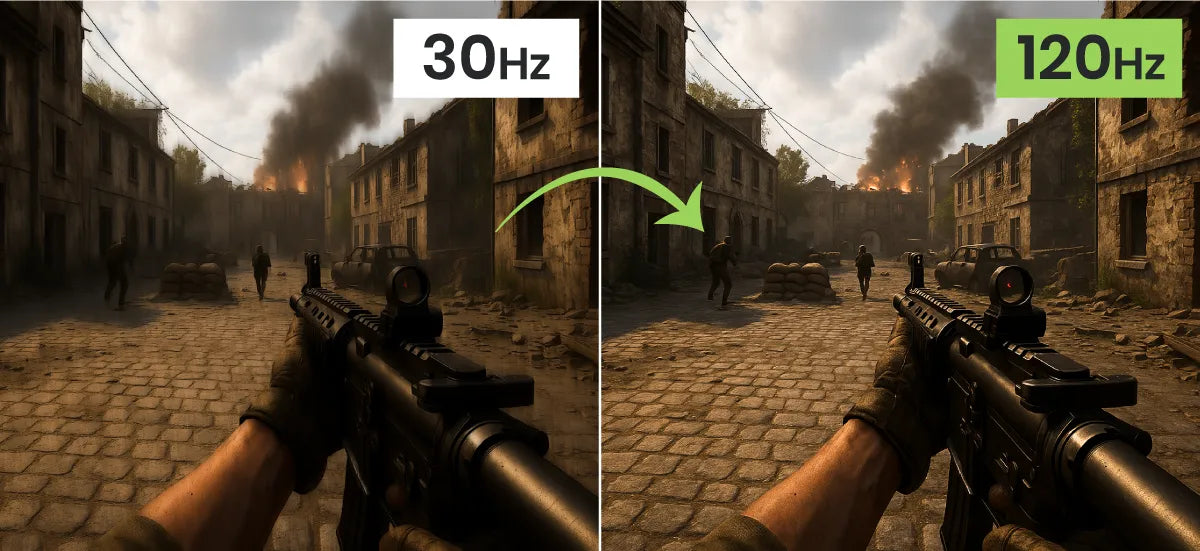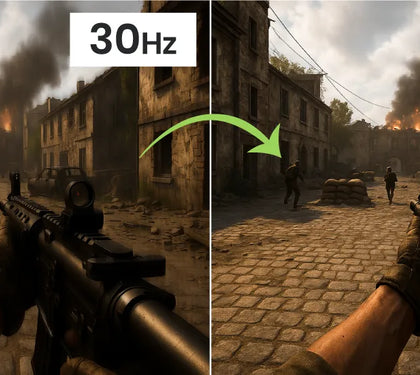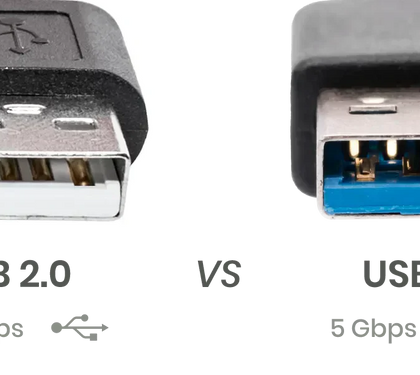FPS (Frames Per Second), also known as frame rate, directly affects visual smoothness in gaming, video playback, and professional workflows like editing or design. This guide explains what FPS is, how it differs from refresh rate (Hz), why it matters for gameplay and productivity, and how to improve frame rates on your devices.
What Does FPS Mean?
FPS (Frames Per Second) measures how many individual images (frames) appear on a screen every second. A higher FPS delivers smoother, more fluid motion—whether you're gaming, watching video, or editing animation.
For example:
-
24 FPS – Standard for films, giving a cinematic feel.
-
60 FPS – Smooth visuals, commonly used in games and live broadcasts.
-
120+ FPS – Ultra-smooth performance for competitive gaming and high-end applications.

Monitor Hz vs. FPS in Games
Is Hz the Same as FPS? What Does Hz Mean on a Monitor?
While often mentioned together, FPS and Hz refer to different aspects of system performance:
-
FPS (Frames Per Second) refers to how many frames your graphics card (GPU) renders each second.
-
Hz (Hertz) refers to your monitor’s refresh rate, or how many times it updates the screen per second.
For example, your GPU might produce 120 FPS, but if your monitor has a refresh rate of only 60Hz, it can only display 60 of those frames each second. This mismatch can result in screen tearing and reduce overall smoothness.
To get the best visual experience, your refresh rate and FPS should be well-matched, ensuring both your display and graphics card are working together efficiently.

How the Human Eye Perceives Frame Rate
How Many FPS Can the Human Eye Perceive?
There’s often debate about the human eye frame rate—how many frames per second we can actually perceive. While the human eye typically perceives smooth motion above 60 FPS, most people can detect differences up to around 200 FPS, especially in fast-paced environments. However, the benefits plateau beyond 120 FPS for general use.
-
Above 60 FPS: Most users notice a significant increase in smoothness.
-
At 120 FPS or more: That’s where competitive players really feel the edge. In high-stakes games like CS:GO or Valorant, 144 FPS or 240 FPS can reduce input lag and make aiming more responsive, which is crucial when milliseconds matter.
For most users though, anything over 120 FPS often brings minimal perceptible improvement.
Is Higher Frame Rate Better?
So, is a higher frame rate always better? Not necessarily. The ideal FPS depends on your activity—gaming, video editing, or general use—so it’s best to choose what fits your needs rather than aiming for the highest number.
What Is a Good FPS for Gaming and Everyday Use?
The ideal frame rate depends on what you're using your display for. While higher FPS generally offers smoother visuals, not every application requires the same level of performance. Below is a quick reference table outlining recommended FPS levels based on common use scenarios, helping you choose the right balance between smoothness, system load, and practicality.
What Is FPS in Gaming and Why Does It Matter?
FPS (Frames Per Second) in gaming refers to how many individual frames are displayed on screen each second during gameplay. It measures how smooth and responsive the visual experience is. A higher FPS leads to:
-
Faster input response – Actions appear on screen with less delay
-
Smoother motion – Reduces visual stutter, especially during fast movements
-
Improved accuracy – Easier to track moving targets and respond quickly
-
More consistent gameplay – Stable frame delivery prevents lag and screen tearing
In short, higher FPS improves performance, visual clarity, and player control, especially in competitive or fast-paced games.
Games That Benefit Most from High FPS
Certain genres demand higher FPS for optimal performance:
First-Person Shooters (FPS)
Games like Call of Duty or Valorant rely on quick reactions and accurate tracking. High FPS improves motion clarity and aiming precision.
Fighting Games
Titles such as Tekken and Street Fighter require frame-perfect input. Higher FPS reduces latency and improves responsiveness during fast-paced sequences.
Racing Games
In simulators like F1 or iRacing, high FPS enhances the perception of speed and distance, helping players make better decisions during races.
Battle Royale Games
Fortnite and Apex Legends combine fast shooting and strategic movement. High FPS ensures smoother control and better accuracy during intense combat.
Multiplayer Online Games (MOBAs)
Games like League of Legends and Dota 2 involve rapid skill usage and movement during team fights, where smooth FPS helps maintain control.

How to Increase FPS on Your System
To enjoy high-FPS performance, both hardware and software must be optimized. Here are the main areas to consider:
1. Monitor with High Refresh Rate
To display high FPS, you need a monitor that supports:
-
120Hz / 144Hz / 240Hz+ refresh rates
-
Technologies like G-Sync (NVIDIA) and FreeSync (AMD) help prevent screen tearing and provide a more fluid experience
2. Graphics Card (GPU)
A capable GPU is critical for rendering high FPS. Popular choices include:
-
NVIDIA: GeForce RTX 30/40 series (e.g., 3080, 4070)
-
AMD: Radeon RX 6000/7000 series (e.g., 6800 XT, 7900 XTX)
3. CPU
Games with heavy logic or AI (e.g., strategy or sim games) benefit from high-performance CPUs:
-
Intel Core i7/i9 or AMD Ryzen 7/9
4. RAM
-
16GB is standard for smooth gaming
-
32GB+ for open-world games or heavy multitasking
5. In-Game Settings
Adjust software settings to boost FPS:
-
Lower resolution (1080p yields more FPS than 4K)
-
Disable intensive effects (shadows, reflections, anti-aliasing)
-
Turn off V-Sync (if tearing isn't an issue)
6. Software Updates
-
Ensure your operating system and GPU drivers are up to date. This often improves compatibility and can resolve performance issues.
7. Stable Internet Connection
-
For online games, a reliable connection complements high FPS. Use a wired Ethernet or fiber connection to reduce lag and packet loss.

Frame Rate Support on Popular Game Consoles
Different gaming consoles support different frame rates depending on hardware and game optimization:
Keep in mind that actual performance depends on the game and its settings.
How to Check FPS on Your Device (What Is My FPS?)
Monitoring FPS can help you evaluate your system’s performance. Here are a few tools:
-
In-game settings: Many games include built-in FPS counters.
-
GPU software: Use NVIDIA GeForce Experience or AMD Adrenalin.
-
Third-party tools: Apps like MSI Afterburner or Fraps provide real-time FPS tracking.
Popular Brands Offering High-FPS Hardware
Monitors (High Refresh Rate)
- ASUS ROG
- Acer Predator
- BenQ ZOWIE
- Dell Alienware
- MSI Optix
- Samsung, LG UltraGear
- Gigabyte AORUS
Graphics Cards (GPU)
- NVIDIA (RTX series)
- AMD (RX series)
- Partners: ASUS, MSI, GIGABYTE, ZOTAC, SAPPHIRE
Processors (CPU)
- Intel Core i7/i9
- AMD Ryzen 7/9
Memory (RAM)
- Corsair, G.Skill, Kingston, Crucial, TeamGroup, ADATA
Supporting Components
- NZXT, Cooler Master, Thermaltake – Cases, cooling
- Elgato – Streaming tools
- Driver Software – NVIDIA GeForce Experience, AMD Adrenalin, Intel DSA
Final Thoughts: Why FPS Still Matters
FPS (Frames Per Second) directly impacts how smooth and responsive your screen feels. For gaming, video, and even productivity, higher FPS means:
-
More immersive visuals
-
Faster reactions
-
Fewer lags or visual glitches
To make the most of high FPS, invest in the right hardware, tune your settings, and ensure your system stays updated. Whether you're a casual player or a competitive pro, optimizing FPS enhances your experience—and your edge.





